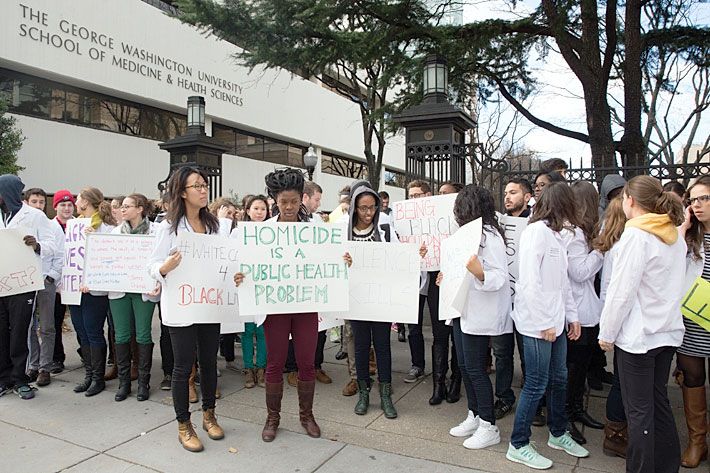Weeks after a grand jury in Missouri failed to indict police officer Darren Wilson in the shooting death in Ferguson, Mo., of Michael Brown, a New York City grand jury chose not to indict a city police officer in the death of Eric Garner. Mr. Garner died after being held in a chokehold while being taken into police custody. The incident, caught on video, attracted national attention and spurred demonstrations across the United States and in cities around the world.
Former federal prosecutor Roger A. Fairfax, professor of law and associate dean for public engagement at the George Washington University Law School and the author of “Grand Jury 2.0: Modern Perspectives on the Grand Jury,” spoke with George Washington Today reporter Ruth Steinhardt about the New York grand jury’s action.
One of the points that came up in our conversation about Michael Brown’s death was that juries tend to favor law enforcement officers when witness testimony conflicts with their accounts. How do we reconcile that with a case like Eric Garner’s, where the confrontation with New York City Police Officer Daniel Pantaleo was caught on video? When a law enforcement officer testifies before a grand jury, as they often choose to do, he or she has the opportunity not only to convey that the episode was the result of a reasonable and necessary use of force, but also to express remorse and sorrow for the loss of life or injury suffered by the victim in the case. This can be a powerful narrative for grand jurors, who may be looking to assign blame for a tragedy.
Mr. Pantaleo’s attorney in this case has, in interviews, given an account of the officer’s testimony before the grand jury. However, some have observed that his reported testimony seems inconsistent at times with what the video of the incident depicts—in particular, the timing of the officer’s release of the hold on Mr. Garner’s neck and whether the officer remained on top of Mr. Garner after Mr. Garner stated he could not breathe.
However, if the prosecutor here did not aggressively challenge the officer’s testimony, the grand jurors may simply have accepted the officer’s version of events despite what the video showed.
The federal investigation into Mr. Garner’s death is ongoing. What avenues might a federal prosecutor have to bring charges against Mr. Pantaleo?
It is a federal crime for a state actor, like a police officer, to willfully deprive an individual of a constitutional right. Mr. Garner, like all of us, had the constitutional right, under the Fourth Amendment, to be free from excessive force. The first question, then, is whether the officers deprived him of that right. The second question will be whether the federal investigators believe they have enough evidence to show that the officers willfully deprived Mr. Garner of that right, essentially meaning that the officers used force with the purpose of depriving him of his Fourth Amendment right.
If, based upon their investigation, the federal prosecutors decide to bring this case, they will present the evidence to a federal grand jury. If that federal grand jury decides that there is probable cause to indict any of the officers, the case would (absent a plea bargain) go to trial. The trial would be public, and the standard of proof would be proof beyond a reasonable doubt.
If there is a conviction in a case like this, where the alleged deprivation of rights results in the death of the individual, the official is potentially subject to a lengthy term of incarceration under the federal civil rights statute.
Would the makeup of the federal grand jury be any different than the ones that determined the state case?
The federal Eastern District of New York, where the case would be venued, covers not only Staten Island, but also Brooklyn, Queens and parts of Long Island. So, although federal grand juries, like those in the New York state system, are made up of 23 people, those 23 federal grand jurors likely will be drawn from a larger geographic area than the grand jury that declined to indict Mr. Pantaleo on state charges in connection with the killing of Eric Garner.


